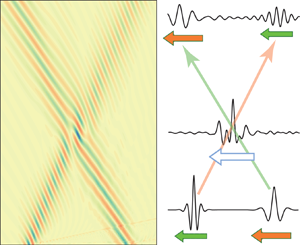Article contents
Breather interactions in a three-layer fluid
Published online by Cambridge University Press: 21 February 2023
Abstract

In a three-layer system with equal upper and lower layer thicknesses that are sufficiently thin and with the same density difference across each interface, breathers have been shown to exist using fully nonlinear governing equations. These breathers are well modelled by theoretical solutions of the mKdV equation, provided the interfaces between the layers do not cross a critical depth. The soliton-like characteristics of fully nonlinear breathers, in particular how two breathers interact, have yet to be explored. Using numerical simulations, this study addresses this shortcoming by studying fully nonlinear overtaking collisions of two breathers in a three-layer symmetric stratification. We apply the fully nonlinear and strongly dispersive FDI-3s internal wave equations, based on a variational principle, in a three-layer system. When the amplitude is small, the analytic breathers fit the wave shapes of the overtaking collision breathers. We find that the larger the upper and lower layer thicknesses are, provided they are below the critical thickness, the more the breathers behave like solitons. We show that an overtaking collision of two breathers is close to elastic.
Information
- Type
- JFM Papers
- Information
- Copyright
- © The Author(s), 2023. Published by Cambridge University Press
References
REFERENCES
- 8
- Cited by


